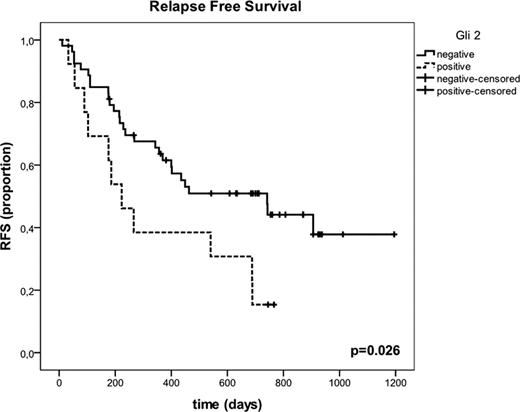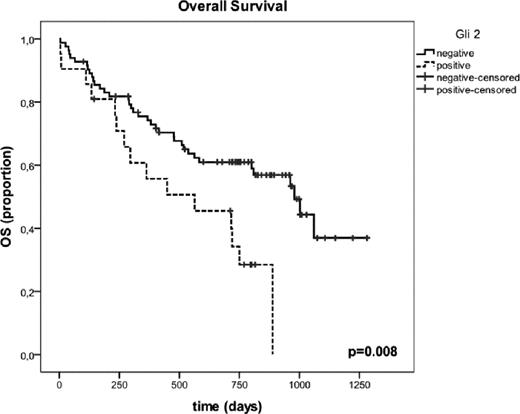Abstract
Abstract 3535
The cancer and leukaemia stem cell hypothesis was first proposed over 40 years ago. This hypothesis suggests that malignant stem cells serve as reservoir for leukaemia cell renewal. Stem cell activators such as Wnt/β-catenin, transforming growth factor β (TGF-β), Notch and Hedgehog signaling pathways have been implicated into stem cell capacity for self-renewal, production of heterogeneous progeny and resistance to chemotherapy. Until now, few data on the contribution of the Hedgehog pathway in acute myeloid leukaemia (AML) exist. Therefore, the aim of this study was to investigate the expression of members of the Hedgehog pathway in primary AML samples and to correlate expression with clinical outcome.
Pre-treatment samples from 95 patients with newly diagnosed AML who were entered into the AMLSG 07–04 trial were analyzed. The trial was conducted between August 2004 and August 2009 (ClinicalTrials.gov Identifier: NCT00151242). In brief, the trial design was as follows: Patients between 18 and 60 years of age with de novo or secondary AML [excluding patients with t(15;17)] were entered into the study. All patients received two induction courses with cytarabine, idarubicin and etoposide. Patients with complete remission (CR) obtained high dose cytarabine consolidation. At study entry patients were randomized between additional therapy with valproic acid, ATRA, both or none. After an interim analysis the randomization to the valproic acid and the combination arm was suspended. Mean follow-up of the analyzed patients was 580 days.
Expression of ligands Sonic, Indian and Dessert Hedgehog, receptors Patched and Smoothened as well as downstream transcription factors Gli1-3 were analyzed by qPCR. No appreciable expression of Sonic, Indian or Desert Hedgehog was found in 30 patients each, and thus no further samples were analyzed. Expression of Smoothened and Patched was found in 73% and 41% of cases, respectively. Mutations within exon 9 or 10 of the Smoothened gene represent a frequent genetic alteration in basal cell carcinomas and medulloblastomas. Therefore, both Smoothened exons have been analyzed by direct sequencing in AML samples. No mutations in Smoothened exon 9 or 10 were found in 30 AML patients. Measurable expression of Gli1, Gli2 and Gli3 was detected in 73%, 22% and 26% of cases, respectively. Patient characteristics including gender, age, categorized karyotype, FLT3 mutation, NPM-1 mutation or MLL status were correlated with the expression of the various members of the Hedgehog pathway. In this analysis, a significant association between FLT3 mutation and Gli2 expression could be established (p<0.001). Clinical outcome of patients was also correlated to Hedgehog expression variables. The CR rate was 57% for Gli2 expressors compared to 71% in Gli2 negative patients. Furthermore, Gli2 expression had a significant influence on relapse free survival and overall survival (p=0.026 and p=0.008, respectively). In conclusion, Gli2 expression in contrast to the more frequently expressed Gli1 is a negative prognostic factor in AML. Blockade of Smoothened activity by specific inhibitors may result in repression of the Gli2 gene and may therefore represent a new therapeutic approach in AML.
Fiedler:Pfizer: Research Funding.
Author notes
Asterisk with author names denotes non-ASH members.



This feature is available to Subscribers Only
Sign In or Create an Account Close Modal